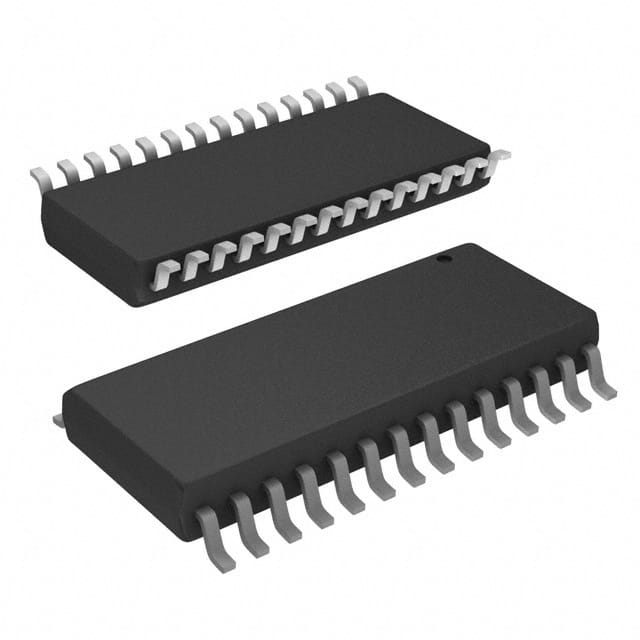Vedi le specifiche per i dettagli del prodotto.

MC908QC8CDZER
Product Overview
Category: Microcontroller
Use: Embedded systems, automotive applications
Characteristics: High-performance, low-power consumption, compact size
Package: Ceramic dual in-line package (CDIP)
Essence: 8-bit microcontroller with integrated peripherals
Packaging/Quantity: Tray packaging, quantity per tray: 100 units
Specifications
- Architecture: 8-bit
- CPU Speed: Up to 8 MHz
- Program Memory Size: 8 KB
- RAM Size: 512 bytes
- Number of I/O Pins: 20
- Operating Voltage Range: 2.7V to 5.5V
- Temperature Range: -40°C to +125°C
- Communication Interfaces: SPI, SCI, I2C
- Timers/Counters: 2 x 16-bit, 1 x 8-bit
- Analog-to-Digital Converter (ADC): 8 channels, 10-bit resolution
Detailed Pin Configuration
The MC908QC8CDZER microcontroller has a total of 28 pins. The pin configuration is as follows:
- VDD - Power supply voltage
- VSS - Ground
- RESET - Reset input
- IRQ - Interrupt request input
- PTA0 - General-purpose I/O pin
- PTA1 - General-purpose I/O pin
- PTA2 - General-purpose I/O pin
- PTA3 - General-purpose I/O pin
- PTA4 - General-purpose I/O pin
- PTA5 - General-purpose I/O pin
- PTA6 - General-purpose I/O pin
- PTA7 - General-purpose I/O pin
- PTB0 - General-purpose I/O pin
- PTB1 - General-purpose I/O pin
- PTB2 - General-purpose I/O pin
- PTB3 - General-purpose I/O pin
- PTB4 - General-purpose I/O pin
- PTB5 - General-purpose I/O pin
- PTB6 - General-purpose I/O pin
- PTB7 - General-purpose I/O pin
- VREFH - High reference voltage for ADC
- VREFL - Low reference voltage for ADC
- AD0 - Analog input channel 0
- AD1 - Analog input channel 1
- AD2 - Analog input channel 2
- AD3 - Analog input channel 3
- AD4 - Analog input channel 4
- AD5 - Analog input channel 5
Functional Features
- High-performance 8-bit microcontroller suitable for embedded systems and automotive applications.
- Low-power consumption allows for efficient operation in battery-powered devices.
- Compact size makes it ideal for space-constrained designs.
- Integrated peripherals such as SPI, SCI, and I2C enable easy communication with other devices.
- Timers/counters provide precise timing control for various applications.
- The built-in ADC allows for analog signal acquisition and processing.
Advantages and Disadvantages
Advantages: - High-performance capabilities for demanding applications. - Low-power consumption extends battery life. - Compact size enables integration into small form factor devices. - Versatile communication interfaces facilitate connectivity with other components. - Precise timing control enhances application functionality. - Analog-to-digital conversion capability simplifies sensor interfacing.
Disadvantages: - Limited program memory size may restrict the complexity of applications. - Limited RAM size may impose constraints on data storage and manipulation. - Limited number of I/O pins may limit the number of external devices that can be connected.
Working Principles
The MC908QC8CDZER microcontroller operates based on an 8-bit architecture. It executes instructions stored in its program memory and interacts with various peripherals to perform desired tasks. The CPU speed of up to 8 MHz allows for efficient execution of instructions. The microcontroller can communicate with other devices using the SPI, SCI, and I2C interfaces. It also features timers/counters for precise timing control and an ADC for analog signal acquisition.
Detailed Application Field Plans
The MC908QC8CDZER microcontroller is widely used in various application fields, including:
- Automotive systems: Used in engine control units (ECUs), body control modules (BCMs), and other automotive electronics.
- Industrial automation: Employed in control systems for machinery, robotics, and process automation.
- Consumer electronics: Integrated into smart home devices, wearable technology, and portable gadgets.
- Medical devices: Utilized in medical equipment such as patient monitors, infusion pumps, and diagnostic devices.
- Internet of Things (IoT): Incorporated into IoT devices for data collection, monitoring, and control.
Alternative Models
10 domande e risposte comuni relative all'applicazione di MC908QC8CDZER nelle soluzioni tecniche
Sure! Here are 10 common questions and answers related to the application of MC908QC8CDZER in technical solutions:
Q: What is MC908QC8CDZER? A: MC908QC8CDZER is a microcontroller from the MC908 family, specifically designed for technical solutions requiring embedded control and processing capabilities.
Q: What are the key features of MC908QC8CDZER? A: Some key features of MC908QC8CDZER include an 8-bit CPU core, flash memory for program storage, EEPROM for data storage, multiple I/O ports, timers, and analog-to-digital converters.
Q: What are the typical applications of MC908QC8CDZER? A: MC908QC8CDZER is commonly used in various technical solutions such as industrial automation, automotive systems, consumer electronics, medical devices, and home appliances.
Q: How much flash memory does MC908QC8CDZER have? A: MC908QC8CDZER has 8 KB of flash memory, which can be used to store the program code that controls the microcontroller's behavior.
Q: Can MC908QC8CDZER communicate with other devices? A: Yes, MC908QC8CDZER supports various communication protocols like UART, SPI, and I2C, allowing it to communicate with other devices such as sensors, displays, and actuators.
Q: Does MC908QC8CDZER have any analog input capabilities? A: Yes, MC908QC8CDZER has built-in analog-to-digital converters (ADCs) that can convert analog signals from sensors or other sources into digital values for processing.
Q: Can MC908QC8CDZER control motors or actuators? A: Yes, MC908QC8CDZER can control motors or actuators by utilizing its I/O ports and timers to generate appropriate signals for driving them.
Q: Is MC908QC8CDZER suitable for battery-powered applications? A: Yes, MC908QC8CDZER is designed to be power-efficient and can operate in low-power modes, making it suitable for battery-powered applications.
Q: Can I program MC908QC8CDZER using a high-level language like C? A: Yes, MC908QC8CDZER supports programming in high-level languages like C, allowing developers to write code more easily and efficiently.
Q: Where can I find documentation and resources for MC908QC8CDZER? A: Documentation, datasheets, application notes, and other resources for MC908QC8CDZER can be found on the manufacturer's website or through authorized distributors.

